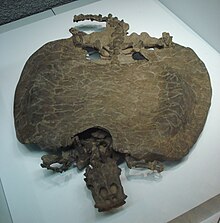| Henodontidae Temporal range: Late Triassic, | |
|---|---|
 | |
| Henodus fossil at University of Tübingen | |
| Scientific classification | |
| Domain: | Eukaryota |
| Kingdom: | Animalia |
| Phylum: | Chordata |
| Class: | Reptilia |
| Superorder: | † Sauropterygia |
| Order: | † Placodontia |
| Superfamily: | † Cyamodontoidea |
| Family: | † Henodontidae von Huene, 1936 |
| Genera | |
| |
Henodontidae is an extinct family of superficially turtle-like placodonts belonging to the superfamily Cyamodontoidea. Fossils have been found in Germany and Spain. [1] [2]






